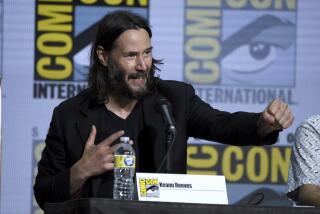Eye on the Ball
Follow the bouncing ball. No, not the insipid two-dimensional image that floats benignly above the musical notes in “Looney Tunes” but the 2.7-gram three-dimensional sphere that moves so fast across a 9-foot-long forest green table that it practically catches fire. Such tables, once the staple of urban Ping-Pong parlors and suburban basements, now exist--at least in this country--mostly in the mind, especially the mind of novelist Jerome Charyn. As Norman Mailer and Joyce Carol Oates chronicled boxing and as baseball has drawn writers as varied as Bernard Malamud and John Updike to ponder its bucolic geometries, the humble, or ferociously arrogant, table game has found its muse in Charyn.
In “Sizzling Chops & Devilish Spins,” Charyn, who clearly loves Ping-Pong as much as he does any of his 34 previous books, gives us both an informed history and an intimate memoir of the game named after its distinctive sound effects. He tracks its origins to Wimbledon, after which aristocrats avoiding the damp British weather headed indoors. The fact that Ping-Pong requires less space than tennis and minimal equipment led swiftly to its widespread popularity, especially in mid-century Manhattan, where the sport reached its heyday.
Charyn leaps forward, like a player lunging to return an unexpected slam, to chronicle America’s two greatest champions, Dick Miles and Marty “The Needle” Reisman, who fought and fought. As Charyn tells it, “[t]here was a lifetime love-hate between them, the yin and yang of American Ping-Pong--one cold, dark, introspective; the other warm, funny, willing to lend you his last hat.” Miles read Joyce and Conrad, while Reisman, dressed in plaid pants and Panama, was like a character out of “Guys and Dolls.” Some of their battles were epic and public--one legendary match took place at Madison Square Garden--but more often than not they played at Lawrence’s near Times Square. Owned by a West Indian--remarkable in the pre-civil rights age, although, quite gloriously, no one cared as long as the tables were level--Lawrence’s too was a uniquely 1950s New York institution. Years earlier, it had been Legs Diamond’s speak-easy and still had a few bullet holes to prove it. Unfortunately, rising real estate prices caused Lawrence’s to close around 1955. It was the beginning of the end.
What else happened to bring Ping-Pong down? In a word: sponge. The advent of a new surface for paddles--that enabled ever trickier spins and increased any force propelled against it--sealed the doom of the masters of the pimpled rubber racket. The game became fiercer and less subtle. Disdaining sponge’s artificial power, men like Reisman could no longer compete at the highest levels and were reduced to curiosities or hustlers as described in Reisman’s own “The Money Player.” “Sizzling Chops” is a lament for their purity in an impure world.
Besides these heroes, Charyn regales us with tales of other colorful Ping-Pong “samurai,” “gypsies,” “matador[s],” “gladiators,” “ballet masters” and “junkie[s]” like Ruth Aarons, America’s only world champion, who retired before she was 20; Auschwitz survivor Alex Ehrlich; and the members of Charyn’s own Parisian club, a.k.a pongistes. Of course, he also goes into detail regarding the “Ping-Pong diplomacy” of the Nixon era, the great success of which was that it opened the door to China, the great failure of which was that, for lack of a single inspirational figure who could do for Ping-Pong what Bobby Fischer did for chess, it did not lead to mass interest in the game.
Desperate for attention, Ping-Pong’s reigning pooh-bahs made rule changes. The size of the ball was increased by two millimeters to make it more visible; the net was lowered three quarters of an inch to ease the larger ball’s passage; and tournament play now has it that whoever is ahead after 20 minutes wins. This is heresy for a game in which the first point in one famous match occurred after more than two hours, with the ball landing an estimated 12,000 times.
Yet the sport endures. With “the ineffable music of its motions, the dancelike gestures at the table, the talent of heart and mind that could bend the body to its own will,” Ping-Pong satisfies with amazing universality. Unlike, say, basketball or football, it doesn’t rely on a body type and, excepting world-class competitions, one can play nearly as well at 80 as at 20, although personal eccentricity may be helpful. Here’s Miles on one of his cohorts: “[H]e got married, got a job, bought a house.... There was always something strange about Lou.”
Obviously, Charyn uses his own sizzling literary chops and devilish metaphorical spins to get his points across the table. His book is a giddy delight and a sweet elegy for the players, their milieu and a way of life.
More to Read
Sign up for our Book Club newsletter
Get the latest news, events and more from the Los Angeles Times Book Club, and help us get L.A. reading and talking.
You may occasionally receive promotional content from the Los Angeles Times.






